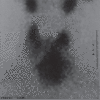Radio-contrast agent-induced hyperthyroidism: case report and review of the literature
- PMID: 26886087
- PMCID: PMC10522297
- DOI: 10.1590/2359-3997000000143
Radio-contrast agent-induced hyperthyroidism: case report and review of the literature
Abstract
A 66 year-old woman with a history of a euthyroid multinodular goiter underwent a head and neck computed tomography (CT) scan (total iodine load of 35 g) in order to evaluate the extent of retrosternal expansion. Less than 24 h after the iodine-based contrast media (ICM) administration, she presented with symptoms and laboratory findings typical of thyrotoxicosis. She was treated successfully with antithyroid medications. This is the shortest time reported in the literature and it is of clinical importance, as it may have an impact to the recommendations given by the attending physician. Given the fact that a large number of ICM examinations are performed in everyday practice, physicians should be aware of this possible thyroid-specific effect. Prophylactic drugs could be considered in high-risk populations, such as administration of perchlorate and a thionamide class drug to elderly patients with suppressed TSH and/or palpable goiter, started the day before and continued for two weeks after ICM administration.
Conflict of interest statement
Disclosure: no potential conflict of interest relevant to this article was reported.
Figures
References
-
- . Van Der Molen AJ. Effect of iodinated contrast media on thyroid function. Thomsen HS (ed). Contrast media: safety issues and ESUR guidelines. Springer, Heidelberg, 2006. p. 77-81.
-
- . Hudzik B, Zubelewics-Szkodzinska B. Radio-contrast induced thyroid dysfunction: is it common and what should we do about it? Clin Endocrinol 2014;80:322-7. - PubMed
-
- . Goodman LS, Gilman A, Brunton LL (eds). Goodman & Gilman’s the Pharmacological Basis of Therapeutics. New York: McGraw-Hill, 2006.
Publication types
LinkOut - more resources
Full Text Sources
Other Literature Sources

